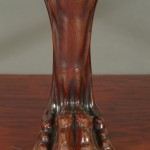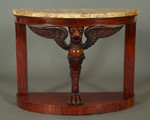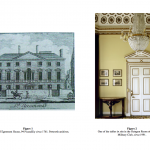9060 AN IMPOSING PAIR OF REGENCY MAHOGANY SEMI-ELLIPTICAL CONSOLE TABLES BEARING FINE ALABASTRO FIORITO VENEERED TOPS English. Early Nineteenth Century.. Measurements: Height: 37″ (94cm) Width: 48 1/2″ (123cm) Depth: 19 1/2″ (50cm)

Research
Of mahogany. Each with semi-elliptical, veneered alabastro fiorito top above a conforming plain frieze, the top raised on a boldly carved winged lion monopodium terminating in a paw foot and two square posts to the rear, the whole raised on a conforming plinth base.
Provenance:
Egremont House, 94 Piccadilly, London.
Until the 1998, property of the Naval and Military Club, Piccadilly.
This impressive pair of tables formerly stood in the grand Palladian mansion at 94 Piccadilly, London, originally known as Egremont House (figure 1).
The house was built in 1761 for Charles Wyndham, 2nd Earl of Egremont by the architect Matthew Brettingham, one of the best-known champions of Palladianism in England, responsible for such impressive country- and townhouses as Norfolk House in St. James’ Square and Kedleston Hall, Derbyshire. For a century the house changed ownership several times. By the 1820s the property had passed into the hands of the Marquess of Cholmondeley, during which time it was known as Cholmondeley House. He was followed by the Duke of Cambridge for whom it was designated Cambridge House, a name which endures to this day, and finally by Lord Palmerston who lived there until his death in 1865.
Shortly thereafter, 94 Piccadilly was acquired by the Naval and Military Club, a gentlemen’s club for officers formed in 1862. It came to be nicknamed the “In and Out Club,” for the conspicuous signposts of its entrance and exit gates. Gentlemen’s clubs in London offered upper class men private spaces in which to socialize, removed from domestic and public stresses. Over 30 clubs, each with its own distinguishing identity, occupied the neighborhood surrounding Pall Mall, St. James’s and Piccadilly.
Figure 2 depicts one of the tables in situ in the Octagon Room of the Naval and Military Club, circa 1991.
It is not certain whether the present tables were already in situ when the Naval and Military Club acquired the mansion. The bases are of exceptionally fine quality, the monopodiae carved from solid mahogany, a great luxury, and the tops are notable for being excellent specimens of Alabastro Fiorito. This indicates they could certainly have been commissioned by the Cholomondeley family during their ownership of the building. But in any case the tables perfectly suited the strong and sober interior decoration of gentlemen’s clubs at that time. Classical architectural elements, luxurious leather seating furniture, imposing mahogany tables and bookcases combined to provide an impressive atmosphere of “quiet, comfortable exclusivity.”1 Interior spaces were outfitted by some of the best known designers of the day; for example British cabinetmakers Holland and Sons were responsible for furnishings at the Athanaeum, the Reform Club, Army and Navy Club, the Oxford Club, the Cambridge Club and the Carlton Club.
The table is a fine example of Regency furniture design, which drew heavily on the study of surviving artifacts from the ancient world, particularly from Greece, Rome and Egypt. The excavations of Pompeii and Herculaneum in the mid-18th century and scholarly campaigns that followed, led to the dissemination of ancient models which were incorporated into furniture by Regency designers. This decorative trend included the use of monopodiae, ornamental supports comprising the head and one leg of an animal, a winged lion in the case of the present piece.
Footnotes:
1. Milne-Smith, Amy. London Clubland: A Cultural History of Gender and Class in Late Victorian Britain. Basingstoke: Palgrave Macmillan, 2011. 2.





Comments are closed.